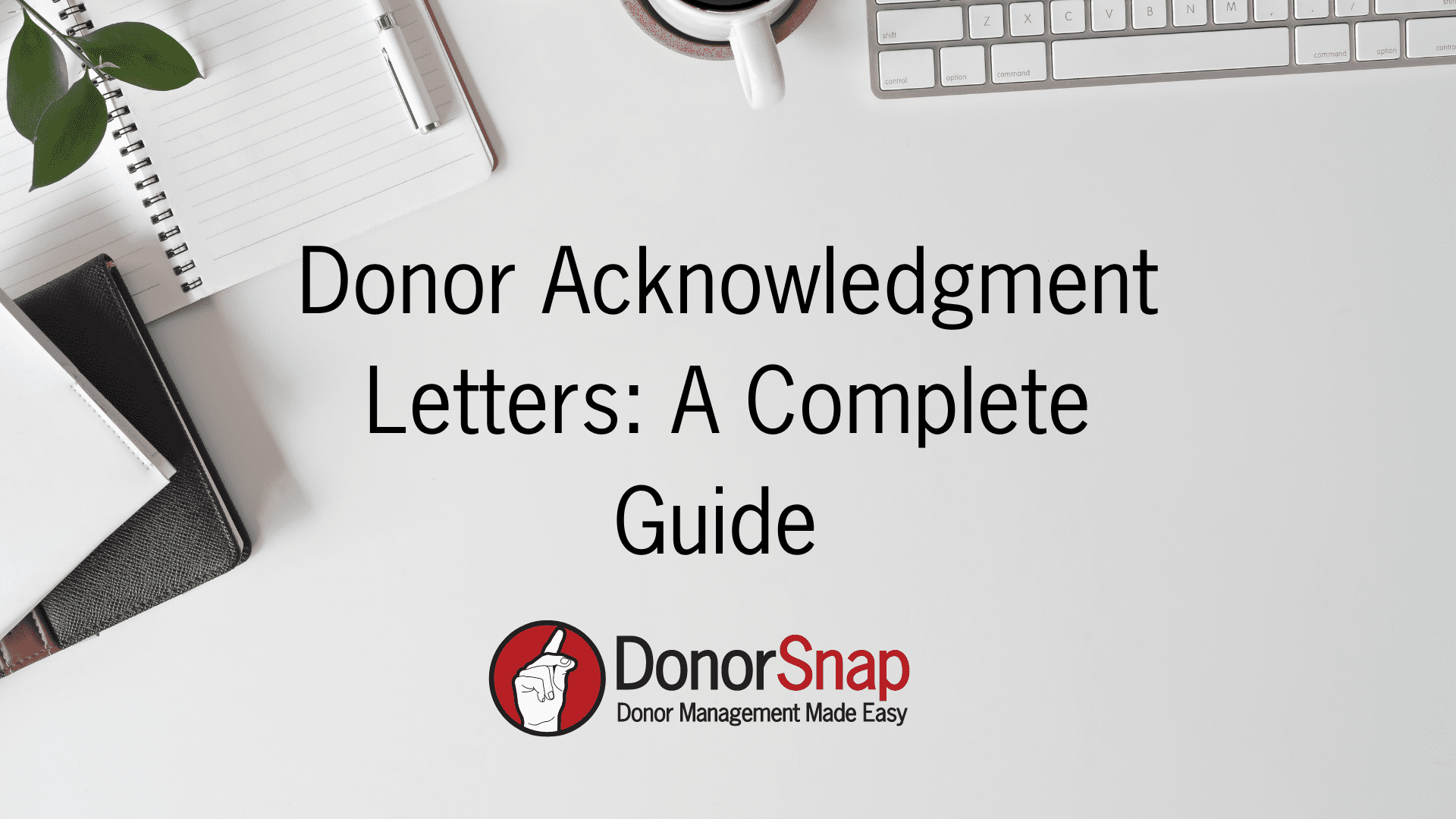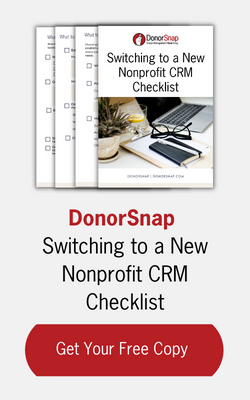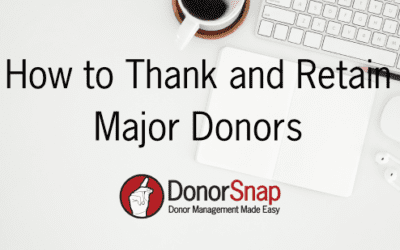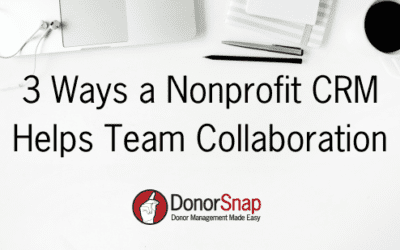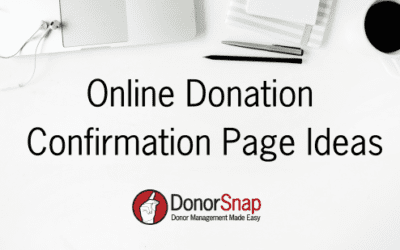Donor acknowledgment letters are a valuable component of donor retention. If you give the same amount of attention to your acknowledgment letters as you do your appeal letters, you can vastly improve your donor retention rate.
Your thank you letters serve a practical purpose, but will they influence whether a donor wants to give again? Keep reading to discover ways you can fine-tune your acknowledgment letters to delight your donors and ensure their continued support.
The Value of Thank You
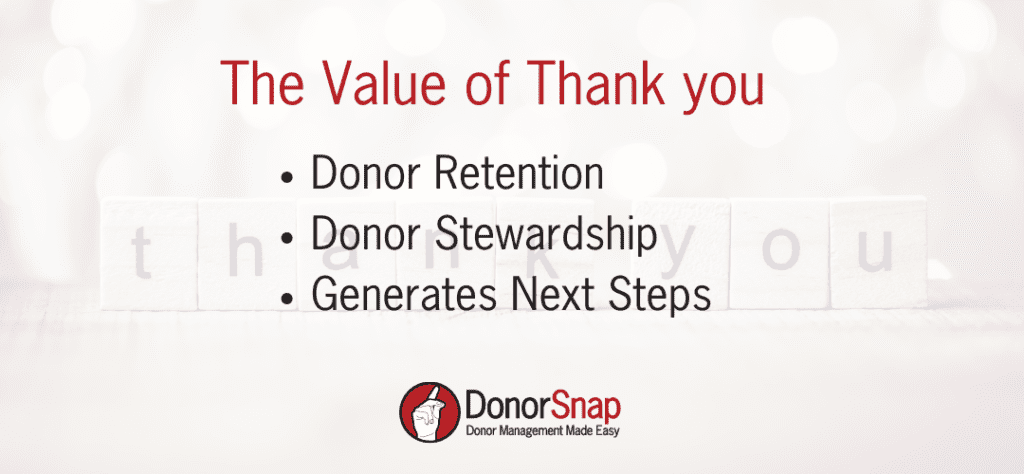
A good thank you can go a long way. Most donors give again because of a stellar acknowledgment process. On the contrary, if your letters are dry, uninspiring, or have inaccurate data, it could turn a donor away. Thank you letters can make or break your donor retention, which is why it is worth your organization’s time to evaluate your acknowledgment process and letters.
Your thank you letters also serve as an opportunity to provide next steps to your donors. As you thank them, think of ways you can draw them further into your organization. For example, invite them to an upcoming event, share your social media channels so they can follow you, or offer opportunities to volunteer.
Thank You Letter Best Practices
There are a number of ways you can ensure your thank you letters are having a positive impact on your donor retention. Consider the following best practices when writing your thank you letters and implementing your acknowledgment process.
- Nonprofits should update their thank you letters yearly (at least)
- Donor Acknowledgement letters should be sent out ASAP (48 hours if possible)
- Thank You Letters to donors should be customized and personalized
- Deliver impact in nonprofit thank you letters
- Acknowledgment letters should be donor-centric
- Do not include an ask in your donation acknowledgment letters
Nonprofits should update their thank you letters yearly

If you are taking the set it and forget approach to writing thank you letters, think again. Just like you update your appeal letters yearly, your acknowledgment letters should be updated often with fresh content.
It can be helpful to write your thank you letters at the same time as your appeal letters. Having a cohesive theme carried throughout your communications will help sharpen your message. Donors will also get the sense you have your operations in order and are more likely to trust you as an organization.
In addition, many people give to your organization year after year. Seeing the same thank you letter will start to feel dull and uninspiring. Make sure each time someone gives, they are getting a beautifully written thank you that is new and has fresh content.
Donor Acknowledgement letters should be sent out ASAP (48 hours)
Ideally, you should be thanking your donors as soon as possible. If possible you should aim to have thank you letters out the door within 48 hours. According to research from GuideStar, donors who are thanked within 48 hours, are 4 times more likely to give again. It also is another way you can build trust with your donors. If they see you are responding promptly to gifts, it reflects positively on your operations. Donors will be more likely to trust that you will responsibly spend their funds.
Thank you letters to donors should be customized and personalized
According to nonprofit times, approximately 71 percent of donors feel more engaged with a nonprofit when they receive content that’s personalized. You should be personalizing every piece of communication you can including your thank you letters.
You should always be addressing your donors by their preferred salutation. Good data entry is key to personalization. Make sure all of your donor and donation details are accurate as inaccurate information can be offputting to a donor. You would never want to address a donor by the wrong name or nickname. For example, if you have a donor named William, do not address them by Bill or Will unless specified this is what they go by.
Another way you can customize your thank you letters is to include information about the donors giving history. Some examples include:
- Thank you for supporting XYZ org since 2017!
- We are so thankful you chose to give to us again!
- We noticed you increased your gift amount and we can’t thank you enough!
Deliver impact in donor thank you letters
One of the most powerful things a nonprofit can do for donor retention is to show the impact of the donor’s gift. The more specific the better. When someone makes a donation to your organization they want to know you are grateful for it. But they also want to know it is being used as they intended and it is having a positive impact on the cause you support. Showing impact builds trust with your donors and will inspire them to give again.
You can show impact in your thank you letters by focusing on a specific area their donation went to help. Donors like to see specifics and details. If you can narrow it down to a detailed story of one person the donation helped, one animal, or one hurdle your organization overcame this will have a profound impact.
Acknowledgment letters should be donor-centric
Making your donation letters donor-centric is pretty simple and will have a profound impact on how your donor feels when they read it. It is natural to want to highlight all of the great things your organization does, but make sure you aren’t just talking about yourself. After all, you are thanking the donor for their gift, so tell them specifically how they made a difference. For example, instead of saying “your donation allowed us to do this great thing” reword it to just say “your gift did this great thing.” This simple shift in language takes you out of the middle and makes the donor feel more connected to their gift and how it helped.
Do not include an ask in your donation acknowledgment letters
It is important to thank your donors more than once before you ask them for another donation. Ideally, you should be finding creative ways to repeatedly thank your donors throughout the year. Your donor acknowledgment letter is the first and most formal thank you to your donors. You should never include an ask for additional donations in your thank you letters. You can use the letter as a springboard for the next steps, such as following your social media accounts or attending an event. This will keep them engaged with your organization, without the pressure of needing to give again so soon.
What to Include in your Donor Acknowledgement Letters?

In addition to these best practices, there are a number of things you should include in your donation thank you letters. When writing your letters or editing them make sure you include the following things:
- Details of the gift & how the gift was used
- IRS Requirements if applicable
- A real signature
- Your logo, mission statement, and branding
- A good PostScript (PS)
Details of the gift & how it was used
In every thank you letter to your donors you should always include the details of the gift. This includes where the gift was directed (ex: unrestricted or to a specific campaign), amount, date, and appeal. In addition, tell the donor exactly where their donation is going. This goes along with the importance of delivering impact. This will help build trust and ensure the donation is going to be spent wisely by your organization.
IRS Requirements if Applicable
Depending on how your nonprofit handles tax receipts, you may need to include IRS requirements in your thank you letters. Some nonprofits choose to send year-end tax receipts, while others include the tax receipt information on their acknowledgment letters, and some do both. You are required by the IRS to provide a tax receipt to all donations of $250 and above but is best practice to give a tax receipt to everyone, even for gifts less than $250.
If your donor acknowledgment letter also intends to be a tax receipt, US IRS requirements are as follows:
A Real Signature
Donor acknowledgment letters should come from a real person. They should read as if an individual is writing the letter to the donors. You should not include wording like “on behalf of the board of directors….” because this makes the letter feel impersonal. At the end of the letter you can type out who is signing the letter, but you should include a real signature and it should be from the person who wrote the letter. If you have time, including a small handwritten personal note on the thank you letter can really go a long way.
Your Logo, Mission Statement and Branding
Every piece of communication your nonprofit sends out should reflect your branding. This includes the use of colors/fonts and your logo. When someone receives the thank you letter they should know it is coming from your organization before they even start reading. Powerful branding can go a long way for a nonprofit organization. It helps build trust and recognition, so don’t forget to brand your thank you letters!
Include a PS
According to NonprofitPro, Seventy-nine percent of donors and prospects who open direct mail appeals will read the postscript first. This is great real estate on your thank you letters if you have an important message you don’t want donors to miss. This could include a way to draw them further into your organization. For example, include an invite to your next event in the PS, or ask them to follow you on social media.
Final Thoughts
Thanking your donors is an invaluable part of your donor stewardship process. Most donors will give again if a nonprofit has a stellar thank you process. There are a number of best practices to consider when creating your donor acknowledgments, including:
- Update thank you letters yearly (at least)
- Send out letters ASAP (48 hours)
- Customize and personalize thank you letters
- Deliver impact in thank you letters
- Acknowledgment letters should be donor-centric
- Never include an ask in thank you letters
When writing your thank you letters, be sure to include the following elements:
- Details of the gift & how the gift was used
- IRS Requirements if applicable
- A real signature
- Your logo, mission statement, and branding
- A good PostScript (PS)
Every nonprofit organization is different with a different audience. So above all, connect with your donors to discover their preferences. Measure and test when trying new methods of communication, and integrate thanking your donors throughout the year into your daily operations.
